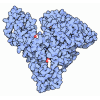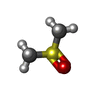[English] 日本語
 Yorodumi
Yorodumi- PDB-8svt: Crystal structure of pregnane X receptor ligand binding domain in... -
+ Open data
Open data
- Basic information
Basic information
| Entry | Database: PDB / ID: 8svt | ||||||
|---|---|---|---|---|---|---|---|
| Title | Crystal structure of pregnane X receptor ligand binding domain in complex with SJPYT-331 | ||||||
 Components Components | Nuclear receptor subfamily 1 group I member 2, Nuclear receptor coactivator 1 fusion protein,Nuclear receptor coactivator 1 | ||||||
 Keywords Keywords | TRANSCRIPTION / Pregnane X receptor (PXR) / promiscuous ligand-activated protein / nuclear receptor subfamily 1 / transcriptional regulator / drug metabolism | ||||||
| Function / homology |  Function and homology information Function and homology informationlabyrinthine layer morphogenesis / regulation of thyroid hormone receptor signaling pathway / positive regulation of transcription from RNA polymerase II promoter by galactose / positive regulation of female receptivity / intermediate filament cytoskeleton / xenobiotic transport / hypothalamus development / male mating behavior / NR1H2 & NR1H3 regulate gene expression to control bile acid homeostasis / steroid metabolic process ...labyrinthine layer morphogenesis / regulation of thyroid hormone receptor signaling pathway / positive regulation of transcription from RNA polymerase II promoter by galactose / positive regulation of female receptivity / intermediate filament cytoskeleton / xenobiotic transport / hypothalamus development / male mating behavior / NR1H2 & NR1H3 regulate gene expression to control bile acid homeostasis / steroid metabolic process / cellular response to Thyroglobulin triiodothyronine / Synthesis of bile acids and bile salts / estrous cycle / Endogenous sterols / Synthesis of bile acids and bile salts via 27-hydroxycholesterol / Synthesis of bile acids and bile salts via 7alpha-hydroxycholesterol / xenobiotic catabolic process / progesterone receptor signaling pathway / nuclear retinoid X receptor binding / Transcriptional regulation of brown and beige adipocyte differentiation by EBF2 / response to retinoic acid / histone acetyltransferase activity / Recycling of bile acids and salts / histone acetyltransferase / cellular response to hormone stimulus / NR1H3 & NR1H2 regulate gene expression linked to cholesterol transport and efflux / estrogen receptor signaling pathway / positive regulation of adipose tissue development / RORA activates gene expression / peroxisome proliferator activated receptor signaling pathway / lactation / positive regulation of neuron differentiation / Regulation of lipid metabolism by PPARalpha / xenobiotic metabolic process / regulation of cellular response to insulin stimulus / cerebellum development / BMAL1:CLOCK,NPAS2 activates circadian gene expression / SUMOylation of transcription cofactors / Activation of gene expression by SREBF (SREBP) / nuclear receptor coactivator activity / hippocampus development / response to progesterone / nuclear receptor binding / nuclear estrogen receptor binding / RNA polymerase II transcription regulatory region sequence-specific DNA binding / SUMOylation of intracellular receptors / Heme signaling / mRNA transcription by RNA polymerase II / Transcriptional activation of mitochondrial biogenesis / PPARA activates gene expression / Cytoprotection by HMOX1 / cerebral cortex development / Transcriptional regulation of white adipocyte differentiation / Nuclear Receptor transcription pathway / RNA polymerase II transcription regulator complex / male gonad development / nuclear receptor activity / sequence-specific double-stranded DNA binding / Circadian Clock / response to estradiol / HATs acetylate histones / DNA-binding transcription activator activity, RNA polymerase II-specific / Estrogen-dependent gene expression / transcription regulator complex / transcription coactivator activity / cell differentiation / nuclear body / protein dimerization activity / DNA-binding transcription factor activity, RNA polymerase II-specific / positive regulation of apoptotic process / RNA polymerase II cis-regulatory region sequence-specific DNA binding / negative regulation of DNA-templated transcription / chromatin binding / regulation of DNA-templated transcription / positive regulation of gene expression / chromatin / positive regulation of DNA-templated transcription / negative regulation of transcription by RNA polymerase II / signal transduction / positive regulation of transcription by RNA polymerase II / protein-containing complex / zinc ion binding / nucleoplasm / nucleus / plasma membrane / cytosol Similarity search - Function | ||||||
| Biological species |  Homo sapiens (human) Homo sapiens (human) | ||||||
| Method |  X-RAY DIFFRACTION / X-RAY DIFFRACTION /  SYNCHROTRON / SYNCHROTRON /  MOLECULAR REPLACEMENT / Resolution: 2.39 Å MOLECULAR REPLACEMENT / Resolution: 2.39 Å | ||||||
 Authors Authors | Garcia-Maldonado, E. / Huber, A.D. / Nithianantham, S. / Miller, D.J. / Chen, T. | ||||||
| Funding support |  United States, 1items United States, 1items
| ||||||
 Citation Citation |  Journal: Nat Commun / Year: 2024 Journal: Nat Commun / Year: 2024Title: Chemical manipulation of an activation/inhibition switch in the nuclear receptor PXR. Authors: Garcia-Maldonado, E. / Huber, A.D. / Chai, S.C. / Nithianantham, S. / Li, Y. / Wu, J. / Poudel, S. / Miller, D.J. / Seetharaman, J. / Chen, T. | ||||||
| History |
|
- Structure visualization
Structure visualization
| Structure viewer | Molecule:  Molmil Molmil Jmol/JSmol Jmol/JSmol |
|---|
- Downloads & links
Downloads & links
- Download
Download
| PDBx/mmCIF format |  8svt.cif.gz 8svt.cif.gz | 133.2 KB | Display |  PDBx/mmCIF format PDBx/mmCIF format |
|---|---|---|---|---|
| PDB format |  pdb8svt.ent.gz pdb8svt.ent.gz | 101 KB | Display |  PDB format PDB format |
| PDBx/mmJSON format |  8svt.json.gz 8svt.json.gz | Tree view |  PDBx/mmJSON format PDBx/mmJSON format | |
| Others |  Other downloads Other downloads |
-Validation report
| Summary document |  8svt_validation.pdf.gz 8svt_validation.pdf.gz | 1 MB | Display |  wwPDB validaton report wwPDB validaton report |
|---|---|---|---|---|
| Full document |  8svt_full_validation.pdf.gz 8svt_full_validation.pdf.gz | 1.1 MB | Display | |
| Data in XML |  8svt_validation.xml.gz 8svt_validation.xml.gz | 23.1 KB | Display | |
| Data in CIF |  8svt_validation.cif.gz 8svt_validation.cif.gz | 31.1 KB | Display | |
| Arichive directory |  https://data.pdbj.org/pub/pdb/validation_reports/sv/8svt https://data.pdbj.org/pub/pdb/validation_reports/sv/8svt ftp://data.pdbj.org/pub/pdb/validation_reports/sv/8svt ftp://data.pdbj.org/pub/pdb/validation_reports/sv/8svt | HTTPS FTP |
-Related structure data
| Related structure data | 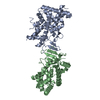 8svnC  8svoC 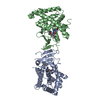 8svpC 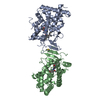 8svqC 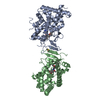 8svrC 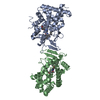 8svsC  8svuC 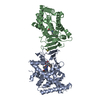 8svxC C: citing same article ( |
|---|---|
| Similar structure data | Similarity search - Function & homology  F&H Search F&H Search |
- Links
Links
- Assembly
Assembly
| Deposited unit | 
| ||||||||
|---|---|---|---|---|---|---|---|---|---|
| 1 |
| ||||||||
| Unit cell |
|
- Components
Components
| #1: Protein | Mass: 39895.633 Da / Num. of mol.: 2 Source method: isolated from a genetically manipulated source Source: (gene. exp.)  Homo sapiens (human) / Gene: NR1I2, PXR, NCOA1, BHLHE74, SRC1 / Plasmid: pET-3A / Production host: Homo sapiens (human) / Gene: NR1I2, PXR, NCOA1, BHLHE74, SRC1 / Plasmid: pET-3A / Production host:  References: UniProt: O75469, UniProt: Q15788, histone acetyltransferase #2: Chemical | Mass: 496.555 Da / Num. of mol.: 2 / Source method: obtained synthetically / Formula: C26H32N4O6 / Feature type: SUBJECT OF INVESTIGATION #3: Chemical | ChemComp-DMS / | #4: Water | ChemComp-HOH / | Has ligand of interest | Y | |
|---|
-Experimental details
-Experiment
| Experiment | Method:  X-RAY DIFFRACTION / Number of used crystals: 1 X-RAY DIFFRACTION / Number of used crystals: 1 |
|---|
- Sample preparation
Sample preparation
| Crystal | Density Matthews: 2.13 Å3/Da / Density % sol: 42.3 % / Description: Rectangular shaped crystal |
|---|---|
| Crystal grow | Temperature: 293 K / Method: vapor diffusion, hanging drop Details: 50 mM Bis-Tris pH 6.0-7.0, 9-16% (v/v) 2-Methyl-2,4-pentanediol PH range: 6.0-7.0 |
-Data collection
| Diffraction | Mean temperature: 100 K / Serial crystal experiment: N |
|---|---|
| Diffraction source | Source:  SYNCHROTRON / Site: SYNCHROTRON / Site:  NSLS-II NSLS-II  / Beamline: 17-ID-1 / Wavelength: 0.92 Å / Beamline: 17-ID-1 / Wavelength: 0.92 Å |
| Detector | Type: DECTRIS EIGER X 9M / Detector: PIXEL / Date: Oct 30, 2022 |
| Radiation | Monochromator: Si(111) / Protocol: SINGLE WAVELENGTH / Monochromatic (M) / Laue (L): M / Scattering type: x-ray |
| Radiation wavelength | Wavelength: 0.92 Å / Relative weight: 1 |
| Reflection | Resolution: 2.39→29.2 Å / Num. obs: 27402 / % possible obs: 99.1 % / Redundancy: 7.4 % / CC1/2: 0.998 / Rmerge(I) obs: 0.09 / Rpim(I) all: 0.035 / Rrim(I) all: 0.097 / Χ2: 0.93 / Net I/σ(I): 14.3 / Num. measured all: 202470 |
| Reflection shell | Resolution: 2.39→2.45 Å / % possible obs: 89.2 % / Redundancy: 6.1 % / Rmerge(I) obs: 0.703 / Num. measured all: 10825 / Num. unique obs: 1789 / CC1/2: 0.82 / Rpim(I) all: 0.3 / Rrim(I) all: 0.767 / Χ2: 0.72 / Net I/σ(I) obs: 2.2 |
- Processing
Processing
| Software |
| |||||||||||||||||||||||||||||||||||||||||||||||||||||||||||||||||||||||||||||
|---|---|---|---|---|---|---|---|---|---|---|---|---|---|---|---|---|---|---|---|---|---|---|---|---|---|---|---|---|---|---|---|---|---|---|---|---|---|---|---|---|---|---|---|---|---|---|---|---|---|---|---|---|---|---|---|---|---|---|---|---|---|---|---|---|---|---|---|---|---|---|---|---|---|---|---|---|---|---|
| Refinement | Method to determine structure:  MOLECULAR REPLACEMENT / Resolution: 2.39→29.2 Å / SU ML: 0.33 / Cross valid method: THROUGHOUT / σ(F): 1.36 / Phase error: 25.77 / Stereochemistry target values: ML MOLECULAR REPLACEMENT / Resolution: 2.39→29.2 Å / SU ML: 0.33 / Cross valid method: THROUGHOUT / σ(F): 1.36 / Phase error: 25.77 / Stereochemistry target values: ML
| |||||||||||||||||||||||||||||||||||||||||||||||||||||||||||||||||||||||||||||
| Solvent computation | Shrinkage radii: 0.9 Å / VDW probe radii: 1.1 Å / Solvent model: FLAT BULK SOLVENT MODEL | |||||||||||||||||||||||||||||||||||||||||||||||||||||||||||||||||||||||||||||
| Refinement step | Cycle: LAST / Resolution: 2.39→29.2 Å
| |||||||||||||||||||||||||||||||||||||||||||||||||||||||||||||||||||||||||||||
| Refine LS restraints |
| |||||||||||||||||||||||||||||||||||||||||||||||||||||||||||||||||||||||||||||
| LS refinement shell |
|
 Movie
Movie Controller
Controller


 PDBj
PDBj






